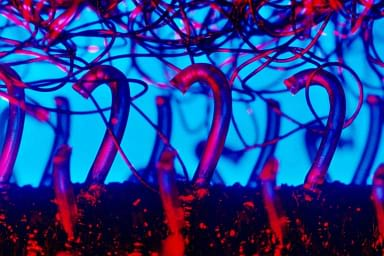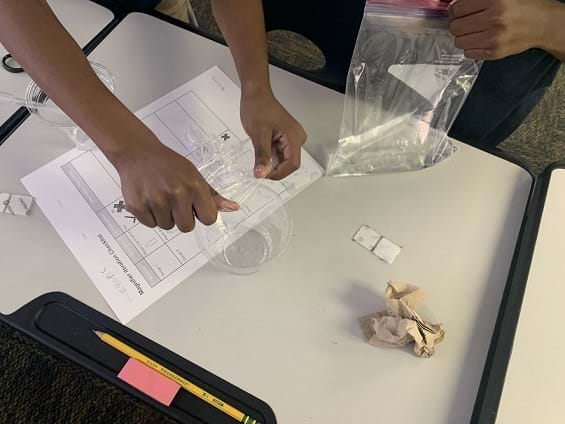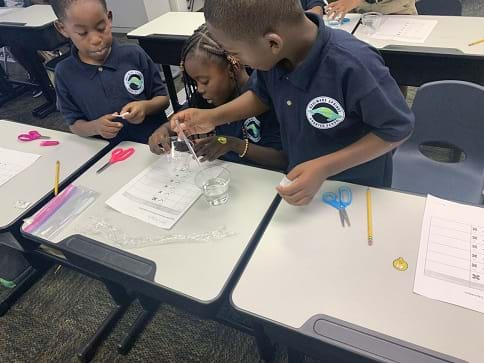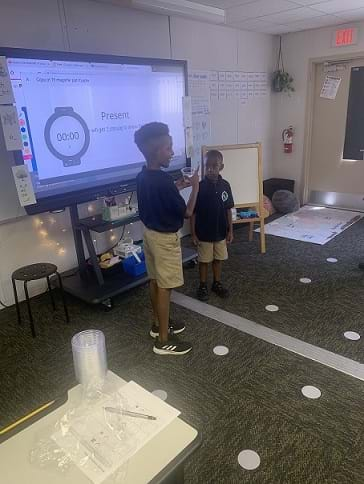Quick Look
Grade Level: 2 (1-3)
Time Required: 2 hours
(four 30-minute class periods)
Expendable Cost/Group: US $0.00
Group Size: 2
Activity Dependency: None
Subject Areas: Earth and Space, Problem Solving, Reasoning and Proof, Science and Technology
NGSS Performance Expectations:

| K-2-ETS1-1 |
| K-2-ETS1-2 |
| K-2-ETS1-3 |

Summary
The hook-and-loop fastener (commonly known as Velcro) is a direct invention of an engineer! In this activity, students are shown a zoomed image of Velcro, and research what magnification is through videos and a read aloud. Students are presented a problem for which they need a magnifier. Students use the engineering design process to make a magnifier or a tool that magnifies their own piece of Velcro. Students test their design and record data.Engineering Connection
Engineers create a variety of imaging technologies that allow us to observe phenomena that exist beyond the range of our five senses. Engineers constantly revise and improve technologies like MRI, CT scan, spectrophotometers, microscopes, telescopes, etc. to assist a variety of engineering fields that rely on magnification technologies. Biomedical engineers rely on magnification technology for the evaluation of cells and materials engineers rely on magnification technology to evaluate the properties of existing materials to assist them in making more new ones.
Learning Objectives
After this activity, students should be able to:
- Describe what a magnifier does.
- Discuss how a magnified image differs from what can be seen with the naked eye.
- Describe what properties of matter can be observed in greater detail with magnification compared to five senses alone.
Educational Standards
Each TeachEngineering lesson or activity is correlated to one or more K-12 science,
technology, engineering or math (STEM) educational standards.
All 100,000+ K-12 STEM standards covered in TeachEngineering are collected, maintained and packaged by the Achievement Standards Network (ASN),
a project of D2L (www.achievementstandards.org).
In the ASN, standards are hierarchically structured: first by source; e.g., by state; within source by type; e.g., science or mathematics;
within type by subtype, then by grade, etc.
Each TeachEngineering lesson or activity is correlated to one or more K-12 science, technology, engineering or math (STEM) educational standards.
All 100,000+ K-12 STEM standards covered in TeachEngineering are collected, maintained and packaged by the Achievement Standards Network (ASN), a project of D2L (www.achievementstandards.org).
In the ASN, standards are hierarchically structured: first by source; e.g., by state; within source by type; e.g., science or mathematics; within type by subtype, then by grade, etc.
NGSS: Next Generation Science Standards - Science
| NGSS Performance Expectation | ||
|---|---|---|
|
K-2-ETS1-1. Ask questions, make observations, and gather information about a situation people want to change to define a simple problem that can be solved through the development of a new or improved object or tool. (Grades K - 2) Do you agree with this alignment? |
||
| Click to view other curriculum aligned to this Performance Expectation | ||
| This activity focuses on the following Three Dimensional Learning aspects of NGSS: | ||
| Science & Engineering Practices | Disciplinary Core Ideas | Crosscutting Concepts |
| Ask questions based on observations to find more information about the natural and/or designed world(s). Alignment agreement: Define a simple problem that can be solved through the development of a new or improved object or tool.Alignment agreement: | A situation that people want to change or create can be approached as a problem to be solved through engineering. Alignment agreement: Asking questions, making observations, and gathering information are helpful in thinking about problems.Alignment agreement: Before beginning to design a solution, it is important to clearly understand the problem.Alignment agreement: | |
| NGSS Performance Expectation | ||
|---|---|---|
|
K-2-ETS1-2. Develop a simple sketch, drawing, or physical model to illustrate how the shape of an object helps it function as needed to solve a given problem. (Grades K - 2) Do you agree with this alignment? |
||
| Click to view other curriculum aligned to this Performance Expectation | ||
| This activity focuses on the following Three Dimensional Learning aspects of NGSS: | ||
| Science & Engineering Practices | Disciplinary Core Ideas | Crosscutting Concepts |
| Develop a simple model based on evidence to represent a proposed object or tool. Alignment agreement: | Designs can be conveyed through sketches, drawings, or physical models. These representations are useful in communicating ideas for a problem's solutions to other people. Alignment agreement: | The shape and stability of structures of natural and designed objects are related to their function(s). Alignment agreement: |
| NGSS Performance Expectation | ||
|---|---|---|
|
K-2-ETS1-3. Analyze data from tests of two objects designed to solve the same problem to compare the strengths and weaknesses of how each performs. (Grades K - 2) Do you agree with this alignment? |
||
| Click to view other curriculum aligned to this Performance Expectation | ||
| This activity focuses on the following Three Dimensional Learning aspects of NGSS: | ||
| Science & Engineering Practices | Disciplinary Core Ideas | Crosscutting Concepts |
| Analyze data from tests of an object or tool to determine if it works as intended. Alignment agreement: | Because there is always more than one possible solution to a problem, it is useful to compare and test designs. Alignment agreement: | |
State Standards
Florida - Science
-
Investigate how magnifiers make things appear bigger and help people see things they could not see without them.
(Grade
1)
More Details
Do you agree with this alignment?
-
Using the five senses as tools, make careful observations, describe objects in terms of number, shape, texture, size, weight, color, and motion, and compare their observations with others.
(Grade
1)
More Details
Do you agree with this alignment?
-
Keep records as appropriate - such as pictorial and written records - of investigations conducted.
(Grade
1)
More Details
Do you agree with this alignment?
-
Ask "how do you know?" in appropriate situations.
(Grade
1)
More Details
Do you agree with this alignment?
-
Raise questions about the natural world, investigate them in teams through free exploration, and generate appropriate explanations based on those explorations.
(Grade
1)
More Details
Do you agree with this alignment?
Florida - Technology
-
Provide and accept constructive criticism on a collaborative project.
(Grades
K -
2)
More Details
Do you agree with this alignment?
-
Solve questions individually and collaboratively using models.
(Grades
K -
2)
More Details
Do you agree with this alignment?
Materials List
For the entire class to share:
- book on engineering: Video: Rosie Revere Engineer or Buy it
- book(s) on magnification: Video: Do Not Lick this Book or Buy it
- pair of Velcro shoes (example pair to show the class, available online; any Velcro example on a piece of clothing or object will do)
- clear tape
- Teacher Assessment Checklist
For each group:
- eye dropper or pipette
- piece of plastic or cling wrap
- plastic cup
- plastic sandwich bags
- cup of water
- pair of scissors
For each student:
- Velcro square, available online
- Magnifier Iteration Checklist
Additional Materials for optional extension
Worksheets and Attachments
Visit [www.teachengineering.org/activities/view/uof-2716-designing-magnifiers-magnification-phenomenon] to print or download.Introduction/Motivation
The phenomenon for this activity will be an image of a magnified piece of Velcro. Students will be prompted to describe the properties of matter they see in the picture while the teacher lists them on the board. They will then be asked what they think it is an image of? After some guesses it will be revealed as Velcro just like on their desk or shoes. Students will be prompted to explore the piece of Velcro on their desk with their naked eye and asked why they think it looks different from the phenomenon. From here the teacher will introduce students to the idea of magnification and students will research what magnification is through videos and read aloud. From here the teacher will then present students with a problem: Oh no my Velcro shoes are broken! I can’t fix the Velcro unless we can magnify it to see what is wrong with the Velcro. Can you help me make a magnifier or a tool that can magnify things? Student pairs will be presented with a variety of materials and tasked with the objective of making a magnifier to magnify their piece of Velcro.
Procedure
Background
Water has the unique ability to magnify images. The surface of a water drop curves outward to make a dome. This outward, or convex, curvature bends light ray’s inward. The result is an enlarged image on the retina of your eye. If students place water over a clear plastic item, they should be able to use it as a magnifier. Just using plastic alone will not result in a magnified image and the shape and quality of the plastic used may result in a clearer image. The goal is for students to discover this phenomenon independently.
Before the Activity
- Gather materials for each pair in bins: 1 cup of water, 1 pipette, 1 scissors, 1 piece saran wrap, 1 clear plastic cup, 1 clear plastic sandwich bag, 1 square Velcro.
- Make student copies of the Magnifier Iteration Checklist
- Make desired teacher copies of the Teacher Assessment Checklist and the Presentation Assessment Rubric.
- Before passing out materials, explain to students what materials they will be using and how to use them safely as an engineer would.
- Demonstrate how to cut plastic cups safely.
- Demonstrate how to use pipette to carefully transfer water.
- Under the Ladybug show students the Magnifier Iteration Checklist and explain how they will use it to record their engineering iterations and observations.
- Set partner work expectations for students and remind them how engineers effectively communicate and collaborate.
- Practice collaboration expectations if needed for 1 - 2 minutes.
With the Students:
- Pass out the Magnifier Iteration Checklist and have students put their names on it.
- Have students pair up.
- Pass out material bins: 1 cup of water, 1 pipette, 1 scissors, 1-piece saran wrap, 1 clear plastic cup, 1 clear plastic sandwich bag, 1 square Velcro.
- Remind students to work together to create a magnifier.
- Set a timer for 10 minutes. Let students explore the materials and try to construct their magnifier.
- Possible ways students can make a magnifier:
- Using the pipette to place a few drops of water in the plastic cup, plastic they cut off the cup, in the clear bag or on a piece of saran wrap.
- Circulate the room and prompt students to try different materials or work together as needed.

A design in progress. - When the 10-minute timer goes off, prompt students to organize their workstation/put away materials.
- Put a 2-minute timer on the board for this transition.
- Go over the Presentation Assessment Rubric with students.
- Put a 2-minute timer on the board to prepare for the presentation.
- Have pairs of their inventions and evaluate.
- Hold post presentation discussion: Prompt students to share strengths and weaknesses of their designs. Prompt students to discuss similarities and differences.
- Have students brainstorm a reiteration they could make based on everyone's designs.
- Teacher makes designs based on student ideas in front of the room.
- Test it out and compare image to phenomenon.
- Discuss why they still do not look the same and what they could do next as engineers to solve this problem.


Vocabulary/Definitions
engineer: A person who uses math and science to design, build or maintain something to solve a problem.
iteration: The repetition of a process or creating a new version.
magnification: The action or process of magnifying something or being magnified, the degree to which something is magnified.
magnifier: A tool used to magnify matter.
magnify: Make matter appear larger than it is.
matter: Anything that takes up space.
prototype: A design created to solve a problem.
Assessment
Pre-Activity Assessment
To assess student background knowledge on properties of matter:
Show students an image of the phenomenon. Prompt them to use the properties of matter to describe the image and list their suggestions on the board.
To assess student background knowledge on five senses:
Ask the students which of their five senses they just used to describe the properties of matter of the substance. This will be a good way to highlight how much information can be just gained through sight, even on things like texture which is normally evaluated through touch. This can help to create relevance for why magnifiers are important (such as to observe things that maybe you cannot touch) later.
To assess student background knowledge on Magnification:
Once they have discussed its: color, shape, size, texture, and how they observed those properties, ask them what they think the substance might be based on all the information they have about it. Write student suggestions on the board. Reveal the substance as Velcro. Put a piece of Velcro on their desk and ask them why it doesn’t look the same. From here students can present any knowledge they may have on magnification.
Activity Embedded (Formative) Assessment
Assess students understanding of magnification during the activity:
Observe students' creation of magnifiers. While doing this they have a checklist of student names to check off for understanding (see Teacher Assessment Checklist). Students demonstrate understanding when they can accurately tell you if their tool is creating a magnified image and how they know. For example, they might say “Yes, because I can see more detail” or “No, because it doesn’t show more detail than I can observe with my naked eye.” This provides the ability to see if students understand what magnification is after the research portion of the process and gives room for them to correct misconceptions and prompt students to reiterate their design as needed.
Optional assessment tools:
Assess students understanding of the engineering design process:
Use the Teacher Assessment Checklist to check for student understanding. Students demonstrate understanding of the engineering design process by being able to tell the teacher what part of the process they are currently in throughout the activity.
To assess ability to design reiterations:
Teachers can use the Teacher Assessment Checklist to check off students who reiterate their designs. If not observed during walk through, students can be prompted to share what they tried and changed or what they would change to improve their design during their presentation. For example, you could ask students when they are sharing their design which parts of their design contributed to magnification. You can then prompt them to share what they think they could do to improve their design based on this.
Collaborative work/ feedback:
Mark off students who are observed using collaborative techniques and participating in providing critical feedback using the compliment sandwich model provided throughout the activity.
Post-Activity (Summative) Assessment
Presentation Rubric: Use the Presentation Assessment Rubric to evaluate students' presentations. Each student's presentation should include a summary of their engineering design process (including possible iterations), how they know their tool was a magnifier, and a demonstration of how their magnifier works.
Making Sense Assessment: Have students reflect on the science concepts they explored and/or the science and engineering skills they used by completing the Making Sense Assessment.
Investigating Questions
What is a magnifier?
Why do scientists and engineers use magnifiers?
How does an engineer work?
Troubleshooting Tips
- You may want to include specified note taking time or go through the Magnifier Iteration Checklist as a class before student presentations to ensure they filled out and recorded their observations.
- It may be beneficial to have students practice using pipettes and practice water handling expectations prior to doing this lab.
- Being prepared for things to get wet and having paper towels or extra worksheets on hand is important.
Activity Extensions
Students leave the initial activity with the question: “Why does the designed magnifier not make the Velcro look the same as the phenomenon image?” They are prompted to consider what engineers would do next given this problem. From here the teacher can extend by having students research hand lens, microscopes, glasses and telescopes through hands-on exploration, videos, and books. They would focus their research on how each magnifier works to magnify an image and under what conditions you would use each magnifier. After each magnifier is researched students would discuss and strategize with their partner what possible revisions, they could make to their original design based on the research. After all desired magnifiers are researched students will be presented with the additional materials, they can use to make iterations. Based on this information, students would plan a revised version of their original magnifier by drawing a model. Students would then build, test, and share their revised design with their partner. They could then collaborate to give each other critical feedback on their designs, with the scripted parameters. If needed students would make any last-minute adjustments to their design. Finally, students would present their results. This activity would extend student knowledge of magnifiers, take them through the engineering design process again and allow for the teacher to extend the activity to a variety of grade levels and levels of complexity.
Activity Scaling
For younger students/ lower grades:
- Pre-cut supplies
- Place students in larger groups with assigned roles
- Extend time
- Only research hand lens, telescopes, or glasses in extension activity
For older students/ upper grades:
- Use as an extension activity
- Provide additional supplies (Different brands of cups or types of water etc.)
- Provide additional constraints (for example, they must be able to use magnifiers at a variety of angles)
- Require a digital presentation
For more advanced students:
- Have students complete more iterations.
- Prompt them to decide what materials they will need for extension based on research.
- Prompt them to complete independent research of why water magnifies.
- Ask students to propose a science question and design an investigation based on questions that came up during the engineering process (i.e., do other liquids magnify?)
Additional Multimedia Support
- Resources used before the activity:
- Rosie Revere Engineer Read Aloud: https://www.youtube.com/watch?v=31eBdgnPsCo
- The Engineer Design Process: A Taco Party: https://www.youtube.com/watch?v=MAhpfFt_mWM
- Resources used in activity:
- Guess the Zoomed in Image #1: https://www.youtube.com/watch?v=WA4Lf2Q8fNw&t=16s
- Do not Lick this book!: https://www.youtube.com/watch?v=mGsCuXONF04&t=5s
- Resources for extension:
- How Microscopes Work: https://www.brainpop.com/technology/scienceandindustry/microscopes/movie
- How Telescope Work: https://www.brainpop.com/technology/scienceandindustry/telescopes/movie
- How Lenses Work: https://www.youtube.com/watch?v=MvUIsetjVck
- How Glasses Help Us See: https://www.youtube.com/watch?v=ypF037wlYZg&t=147s
- Science Tools: Magnifying Glass: https://www.youtube.com/watch?v=AmrFkCwd1Lc
Subscribe
Get the inside scoop on all things TeachEngineering such as new site features, curriculum updates, video releases, and more by signing up for our newsletter!More Curriculum Like This

Students learn about the function and components of the human nervous system, which helps them understand the purpose of our brains, spinal cords, nerves and five senses. In addition, how the nervous system is affected during spaceflight is also discussed.
Copyright
© 2023 by Regents of the University of Colorado; original © 2022 University of FloridaContributors
Aubriel SweeneySupporting Program
Multidisciplinary Research Experiences for Teachers of Elementary Grades, Herbert Wertheim College of Engineering, University of FloridaAcknowledgements
This curriculum was based upon work supported by the National Science Foundation under RET grant no. EEC 1711543— Engineering for Biology: Multidisciplinary Research Experiences for Teachers in Elementary Grades (MRET) through the College of Engineering at the University of Florida. Any opinions, findings, and conclusions or recommendations expressed in this material are those of the authors and do not necessarily reflect the views of the National Science Foundation.
Last modified: May 5, 2023







User Comments & Tips